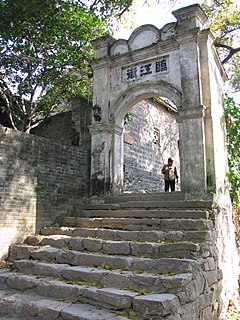 W
WFancheng is a district of the city of Xiangyang, Hubei, People's Republic of China.
 W
WHuanbei is the site of a Bronze Age city on the northern outskirts of the modern city of Anyang in Henan province, China, discovered in 1999. The name refers to its position to the north (běi) of the Huan River. The city seems to have been burnt to the ground after 50 years of occupation, shortly before the construction on the other side of the river of the site now known as Yinxu, the source of the earliest Chinese written records, oracle bones relating to the last nine kings of the Shang dynasty. Huanbei is accordingly assigned to a "Middle Shang" period.
 W
WLuodai is an ancient town in the Sichuan province in southwest China. It is located about 20 km from downtown Chengdu. It has about 23,000 inhabitants, of which about 20,000 are Hakka people.
 W
WMelikawat is an archaeological site located 18 miles south of Hotan, Xinjiang in north-western China. It was once a city that functioned as a major Buddhist center in the Kingdom of Khotan and may have been the kingdom's capital. The first inhabitants of the site were probably Tocharians. Today, the site contains the remains of walls, glass and pottery.
 W
WMiran is an ancient oasis town located on the southern rim of the Taklamakan Desert in Xinjiang, Northwest China. Located where the Lop Nur desert meets the Altun Shan mountains, Miran was once a stop on the famous trade route known as the Silk Road. Two thousand years ago a river flowed down from the mountain and Miran had a sophisticated irrigation system. Now the area is a sparsely inhabited, dusty region with poor roads and minimal transportation. Archaeological excavations since the early 20th century have uncovered an extensive Buddhist monastic site that existed between the 2nd to 5th centuries AD, as well as the Miran fort, a Tibetan settlement during the 8th and 9th centuries AD.
 W
WNanxun is a historic town in Nanxun District of Huzhou, Zhejiang, China. As of the 2007 census it had a population of 119,300 and an area of 141-square-kilometre (54 sq mi).
 W
WTanheli is an archaeological site in Ningxiang, Hunan, one of major national historical and cultural sites in Hunan.
 W
WWuhuang is a town in the Yanjiang District of Ziyang, Sichuan, China. Its population was 40,004 as of 2010. The subdistrict's postal code is 512002110000.
 W
WXiangzhou District is a district of the city of Xiangyang, Hubei, People's Republic of China. The district itself was formerly known as Xiangyang (襄阳区). It was a city famous for the Siege of Xiangyang (1267–1273) by invading forces of the Mongol-founded Yuan Dynasty. It was also an important city during the period of the Three Kingdoms, in the Romance of the Three Kingdoms it was said that it was nearby Xiangyang that Zhuge Liang received his three visits from Liu Bei. Xiangyang was also where Sun Jian fought Liu Biao in 191 AD during the Three Kingdoms. Today, Xiangzhou has been incorporated with nearby Fancheng to form the prefecture-level city of Xiangyang, part of Hubei province.
 W
WXitang, formerly known as Xietang, Pingtang and Xutang, is a historic town in Jiashan County, Zhejiang, China. It borders Luxu Town in the north, Yaozhuang Town in the east, Ganyao Town in the southeast, and Tianning Town and Town in the west. As of the 2016 census it had a population of 57,400 and an area of 83.61-square-kilometre (32.28 sq mi). Xitang is a water town crisscrossed by nine rivers. The town stretches across eight sections, linked by old-fashioned stone bridges. In the older parts of town, the buildings are set along the banks of the canals, which serve as the main transportation thoroughfares in the area.
 W
WYangmei Ancient Town is a traditional town located on the Yong River in Nanning, Guangxi, China. The town's population is approximately 5,300.
 W
WZhūxiān is a town located at the southwest of the city of Kaifeng in eastern Henan province, People's Republic of China. It is under the administration of Xiangfu District. The Gulu River runs through the town. In ancient times, the river was a large tributary of the Huai River, and one could reach Yangzhou via the waterways. From the Tang Dynasty to Republican China, the town was in an important strategic location for land and riverborne communications. During the Southern Song Dynasty, general Yue Fei won an important battle against the Jin at nearby Yancheng and Advanced to Zhuxian. Along with Foshan, Jingde, and Hankou, Zhuxian is regarded as one of the "four ancient towns of Qing Dynasty China". In 2007, Zhuxian was included in the list of 10 most beautiful village-towns in China.